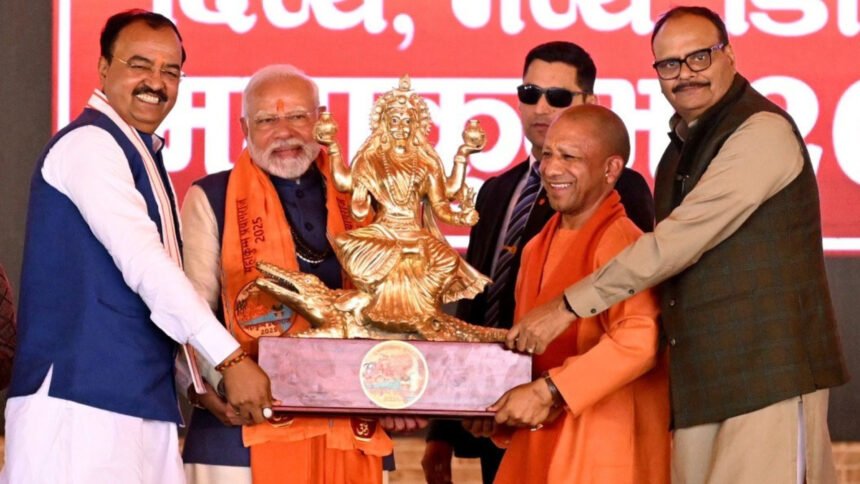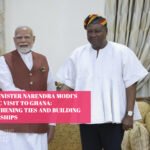Prime Minister Narendra Modi announced on Friday that the Maha Kumbh 2025 will be a significant “great ritual of unity,” designed to enhance India’s cultural and spiritual identity. He highlighted the event’s significance in fostering social harmony and empowering local communities. During a public meeting, he inaugurated several developmental projects designed to enhance the city’s infrastructure and improve facilities for pilgrims attending the Kumbh Mela. Modi pointed out that the Maha Kumbh is a unique occasion where differences among castes and sects fade away.
While launching these initiatives, Modi emphasized the importance of Prayagraj as a spiritual hub, where the sacred confluence of the Ganga, Yamuna, and Saraswati rivers unites people from all backgrounds. He noted that the upcoming Kumbh Mela, scheduled from January 13 to February 26, is expected to attract over 40 crore devotees, making it one of the largest religious gatherings in the world.
Prime Minister Narendra Modi performed the ceremonial “Kumbh-abhishek” of the Kumbh Kalash and initiated projects worth approximately ₹5,500 crore in Sangam. He remarked that “a new history is being created in Prayagraj,” criticizing previous governments for neglecting the Maha Kumbh’s religious importance, which led to difficulties for devotees. Modi suggested that this oversight stemmed from a lack of connection to the country’s cultural heritage among those in power.
The Prime Minister highlighted that both the central and state governments honor the country’s faith and culture, which is why substantial funds are being allocated for development projects to ensure the success of the upcoming 45-day Maha Kumbh event starting in January 2025.
Modi stated, “The comprehensive approach of the government is evident in this Maha Kumbh,” and he assured that measures have been taken to enhance connectivity for the devotees attending the event. He noted that millions of people from various states would gather, each bringing different languages and beliefs, but all united in their pilgrimage to Sangam city.
He mentioned that this time, millions of people would gather in Prayagraj from various states for the Maha Kumbh. “The Prime Minister stated that although individuals may speak different languages and follow various religions, they will all come together as one in Sangam city.”
Prime Minister Modi referred to the Maha Kumbh as a “great sacrifice of unity,” stating that at this event, “all forms of discrimination are set aside.” He emphasized that every Indian who bathes in the Sangam embodies the spirit of “One India, Great India.”
Modi highlighted that a key aspect of the Maha Kumbh tradition is its ability to guide the nation. He noted that during this gathering, significant discussions take place regarding the country’s pressing issues, with saints and sages engaging in dialogue that revitalizes national thought and provides new directions. He pointed out that important decisions affecting the country have often emerged from such gatherings, which historically facilitated major social changes even before modern communication methods existed.
He added that during the Kumbh, learned individuals would come together to reflect on society’s joys and sorrows, contemplating both present challenges and future possibilities. Modi reiterated that the importance of events like the Maha Kumbh remains unchanged, as they send a positive message throughout the nation and encourage collective reflection on national issues.
The Prime Minister highlighted that Prayagraj is significant as it is the land of Nishadraj, with Shringverpur—considered Nishadraj’s kingdom—playing a key role in Lord Ram’s journey to becoming Maryada Purushottam. He mentioned that Shringverpur Dham is undergoing development, and the statues of Lord Ram and Nishadraj will symbolize equality and harmony for future generations.
Modi asserted that his government is dedicated to enhancing the nation’s heritage while also focusing on development. He mentioned several religious circuits currently being developed, such as the Ramayana Circuit, Shri Krishna Circuit, Buddhist Circuit, and Tirthankar Circuit. The Prime Minister emphasized the importance of promoting locations that had previously been overlooked. Using Ayodhya and the construction of the Ram Temple as an example, he stated, “We have all seen how the magnificent Ram Temple has transformed Ayodhya.” He added that places like Vishwanath Dham and Mahakal Mahalok are now recognized globally.
Additionally, Modi mentioned projects like the Akshay Vat Corridor, Hanuman Temple Corridor, and Bhardwaj Rishi Ashram Corridor as reflections of this vision. He noted that sites such as Saraswati Koop, Patalpuri, Nagvasuki, and Dwadash Madhav Temple are also being revitalized for the benefit of devotees.
Prime Minister Modi highlighted that Maha Kumbh 2025 will utilize advanced technology, unlike the previous event in 2013. He introduced the Kumbh Sahayak Chatbot, which will assist users in 11 languages, and proposed a photography competition to engage younger attendees and promote the event on social media. Modi also noted that the Maha Kumbh is expected to boost local economic activity.
He emphasized that this year’s Kumbh will enhance the visitor experience through modern innovations. The chatbot aims to provide real-time assistance and information, ensuring a seamless experience for pilgrims. Modi expressed confidence that these technological advancements would enrich the spiritual atmosphere and positively impact the local economy during this significant event.










